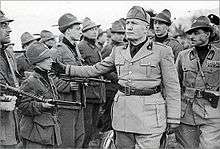Black Brigades
| Part of a series on |
| Fascism |
|---|
 |
|
Organizations |
|
Lists |
|
|
Corpo Ausiliario delle Squadre d'azione di Camicie Nere (Auxiliary Corps of the Black Shirts' Action Squads) Guardia Nazionale Repubblicana (Italian National Republican Guard) | |
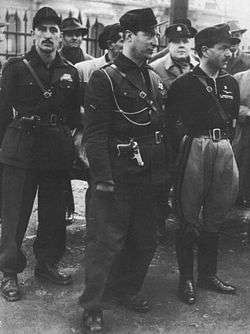 Alessandro Pavolini, commander-in-chief of the Black Brigades (right) and Vincenzo Costa (center), commander of 8th Black Brigade "Aldo Resega" of Milan, at a ceremony in Milan, late 1944. | |
| Organization overview | |
|---|---|
| Formed | November 24, 1943 |
| Preceding organization | |
| Dissolved | April 25th, 1945 |
| Type | Paramilitary, Gendarmerie |
| Jurisdiction | Italian Social Republic (RSI) (northern Italy), under President Duce Benito Mussolini |
| Headquarters | Milan, Italy |
| Employees | 2,000 members |
| Minister responsible |
|
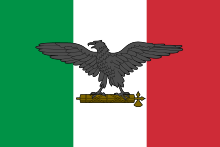
The Corpo Ausiliario delle Squadre d'azione di Camicie Nere (Italian: Auxiliary Corps of the Black Shirts' Action Squads), most widely known as the Black Brigades (Italian: Brigate Nere) was one of the Fascist paramilitary groups, organized and run by the Republican Fascist Party (Partito Fascista Repubblicano, PFR) operating in the Italian Social Republic (in northern Italy), during the final years of World War II, and after the signing of the Italian Armistice in 1943. They were officially led by Alessandro Pavolini, former Minister of Culture (MINCULPOP) of the fascist era during the last years of the Reign of Italy.
History
Background
On 26 July 1943 Italian dictator, Benito Mussolini, was arrested after the Italian Grand Council of Fascism (Gran Consiglio del Fascismo), with the support of King Vittorio Emanuele III, overthrew him and began negotiations with the Allies for Italy's withdrawal from the war. The Italian government was taken over by Marshal Pietro Badoglio, who outlawed the Italian National Fascist party (Partito Nazionale Fascista, PNF) and confiscated all of its assets.
On 12 September Mussolini was rescued by German paratroopers led by Otto Skorzeny. He was then installed by the Germans as the President of the Italian Social Republic (RSI). The RSI was to be an Italian regime which was to nominally administer the German-occupied northern Italy. As the Milizia Volontaria per la Sicurezza Nazionale (MVSN, also known as "Blackshirts") had been disbanded in August by the terms of the armistice, the Guardia Nazionale Repubblicana was formed on 24 November 1943, and was to constitute the new fascist police force. The Guardia Nazionale Repubblicana was formed out of local police, ex-army, ex-Blackshirts and others still loyal to the fascist cause.[1] Anti-fascist political forces in northern Italy, on their side, decided to oppose in arms against the RSI and the German occupants, and began to recruit armed clandestine formations for guerrilla and urban warfare, with support from Allies. Soon, a bloody civil war started in northern Italy.[2]
Constitution
However, as soon as the fascist party in the RSI was reopened and reorganized as Republican Fascist Party (Partito Fascista Repubblicano - PFR), its members began to organize "private" armed units, to protect themselves and party officials from attacks by Italian resistance fighters, who actually started very soon to target RSI authorities and supporters. RSI manpower proved to be insufficient, and Italian authorities decided to organize all fascist party volunteer units in a dedicated structure, and to raise new forces.[3][4] The Black Brigades were formed from members of the Republican Fascist Party. Formation of the Black Brigades was sanctioned by a Fascist Republican Party decree issued personally by Benito Mussolini, head of PFR and of the RSI government, dated 30 June 1944, stating that all existing fascist armed units were to be enlisted into a military organization called Corpo Ausiliario delle Squadre d'Azione di Camicie Nere, and that every local Federation of the PFR (there was one in every Italian province) had to raise a military unit drafting personnel from its members. Units so formed were to be called "Black Brigades", and were to be commanded by the local Federal Secretary of the PFR, with the rank of Major or Colonel.[5]
Their duties were:
- to provide security for the members and assets of the PFR;
- to cooperate with German and Italian law enforcement authorities;
- to help military authorities in counter-insurgency operations.[6]
This measure was to be both a response to resistance attacks against fascist members, and to turn the PFR into a fighting force to cope with shortage of manpower for internal security.[7] Moreover, Mussolini and other fascist leaders felt that the Fascist Party was more true to its ideology if brought back to its original spirit, when it was manned mainly by soldiers and veterans and was above all a fighting organization. In this optic, they decided to mobilize it for war duties, under the concept that every fascist was to be first of all a combatant, and had to take arms for the defense of Italy and fascism.[8] Black Brigades membership was compulsory for all members of the PFR deemed fit for such duties. Members were officially called Squadristi (Squad-men) (like the very first fascist Black Shirts of 1920s), and were divided into three categories: Squadristi Permanenti (Full-time squad-men), Ausiliari di pronto impiego (Ready Response Auxiliaries), Ausiliari (Auxiliaries). Only full-time personnel were required to be on duty daily, while other two categories were to be mobilized only in case of emergency.[9] Black Brigade members were entitled to police powers, to carry firearms and to circulate freely even during curfew. Full-time personnel received a monthly wage of ITL 200.00[10]
Operational service
Police effectiveness of Black Brigades was, in best terms, feeble. Aside from particularly strong and well equipped Brigades (such as VIIIth "Aldo Resega" of Milan, 2000 strong) that were exceptions, the average Black Brigades were at most 2-300 men strong, poorly equipped and armed, with little if not military training, and were hardly in conditions to defend themselves from partisan attacks, not to mention provide support to military authorities.[11]

Many of their members were obscure figures evicted from police or army, and conspicuous were also the hardline fascists who were pushed by resentment and revenge towards that part of Italian population who, in their eyes, betrayed the Fascist regime. Many were also old "Squadristi" fascists who had served in the '20s, and who were eager to retake a first-place role in the ranks of the Fascist Party. In general terms, poor average discipline made all these individuals difficult to control, and prone to abuses. As the military situation worsened, German mistrust towards the RSI military grew, and even Social Republic authorities looked at the Black Brigades with contempt. All these factors contributed to push the Black Brigades into political radicalization and an increasingly hostile behaviour towards the population itself, among which they gained a fearsome reputation of fanatical brutality and summary procedures. Apart from a few Black Brigades who had been found reliable enough to be committed in regular combat against Partisans and Allies, most of these formations had poor military or even police capabilities and were mainly employed in static guard duties, patrols, and were often unleashed in brutal reprisals and retaliations against Partisans' attacks and ambushes to RSI military personnel.[12] There, they usually performed well enough, displaying undeniable bravery but also brutality (which the Partisans promptly reciprocated), in the merciless guerrilla warfare that ravaged northern Italy in 1944-45. Therefore, they were an important law enforcement instrument for German and Italian authorities.[13]
The Brigade members not only fought the Allies and the Italian partisans, but they also fought against political opponents and other Black Brigade members whose support of "the cause" was deemed less than exuberant. Many Black Brigade members were killed in this type of in-fighting.
After the armistice (April 25th, 1945) and the end of the war in Italy, many members of the Black Brigades suffered harsh reprisals from Partisan forces. To this day, the number of Black Brigades soldiers who fell victim of summary executions remains unknown.[14] [15]
Uniforms
Members of Black Brigades were issued standard Italian army uniforms, and they tended to wear them with a black turtleneck sweater, or (in summer) the famous black shirt, as the symbol of loyalty to Mussolini and membership of the Republican Fascist Party. They sometimes wore this uniform with a windproof jacket in solid or camouflage colors. Members of Black Brigades tended to wear the grey-green uniform pants, but a wide array of uniforms were issued and, especially in closing stages of the war, Black Brigades members used just anything they could obtain: army camouflaged one-piece suits, smocks and pants, paratroopers' collarless jump jackets (very popular), tropical Italian army uniforms, German pants and feldjacken, and frequently local produced uniforms and gear.[16]
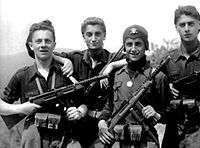
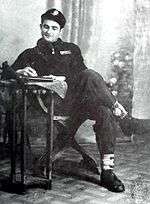
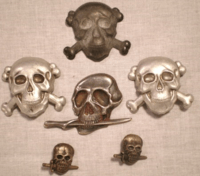

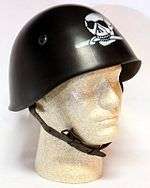
The badge or insignia of the Black Brigades was the jawless death's head, with a dagger in its teeth, or one of assorted Italian versions. Collar tabs were issued, unique to the Black Brigades, consisting in square-shaped tabs with pointed tip, of solid black cloth, on which was pinned a bright red republican fascio, in the lower part. In the upper part, every Brigade chose its own insignia: either one of the many variants of skulls (with or without crossbones) or coloured facing. Regulations prescribed for all members of the Black Brigades to wear a metal enamelled breast badge, of roundel shape, showing a golden fascio amidst Italian national colours in vertical stripes, and surrounded by a black enamel rim with the inscription: "Corpo Ausiliario delle Squadre d'Azione di Camicie Nere", in capital letters, and in the lower part the identification number of the Brigade. Contemporary pictures show that this badge however, although certainly issued on large scale, was not so often worn.
Many Black Brigades adopted sleeve badges, following Italian military tradition, both cloth and metal. These were usually of very fine workmanship, often minted and enamelled, and are today high-priced collectors items. Rank insignias were the same of those prescribed for the Italian army; however, were rarely worn. Towards the end of the war a specific rank system was introduced for the Black Brigades, unique to them, but it does not seem to have ever been implemented.[17]
The majority of Black Brigade members wore Italian army ski caps or berets dyed black. Some photos show members also wearing black German-style caps. Some were Italian made, some were supplied by Germany. Combat headgear was the ubiquitous M33 olive-green helmet, sometimes adorned with Black Brigades' skull insignia. German M35 helmets were also used, ando so were M33 black MVSN helmets. Helmets were often sprayed with various camouflage pattern, as was very common in that period. Combat gear and carrying equipment was the same of army soldiers. Samurai magazine vest, originally intended for elite army units, was widely used and so were a vast sorting of pouches, magazine-holders, holsters, both official issue (Italian or German) and privately made, carried on Italian M1908 olive-green leather carrying equipment.[18]
Weapons
Carcano M91
Carcano M91/38
MAB18
MAB38
OVP
FNAB-43
OG-43
OG-44]]
TZ-45
Isotta Fraschini]]
Beretta M34
Beretta M35
Glisenti Model 1910
Bodeo M89
Breda M30
Breda M35
Organization
The Black Brigades were not actually brigade-sized units. The Italian word brigata has a looser meaning as a synonym of "group" or "assembly". The Black Brigades were typically weak battalions or strong companies, each comprising 200 to 300 men. There were 41 territorial brigades. The territorial brigades were numbered 1 through 41. There were also seven "independent" and eight "mobile" brigades. The mobile brigades were numbered 1 through 7, plus the Second Arditi Brigade.
- Piedmont Regional Inspectorate
- I Brigata Nera "Ather Capelli" Turin
- II Brigata Nera "Attilio Prato" Alessandria
- III Brigata Nera "Emilio Picot" Aosta
- IV Brigata Nera "Luigi VIale" Asti
- V Brigata Nera "Carlo Lidonnici" Cuneo
- VI Brigata Nera "Augusto Cristina" Novara
- VII Brigata Nera "Bruno Ponzecchi" Vercelli
- Lombardy Regional Inspectorate
- VIII Brigata Nera "Aldo Resega" Milan
- IX Brigata Nera "Giuseppe Cortesi" Bergamo
- X Brigata Nera "Enrico Tognu" Brescia
- XI Brigata Nera "Cesare Rodini" Como
- XII Brigata Nera "Augusto Felisari" Cremona
- XIII Brigata Nera "Marcello Turchetti" Mantua
- XIV Brigata Nera "Alberto Alfieri" Pavia
- XV Brigata Nera "Sergio Gatti" Sondrio
- XVI Brigata Nera "Dante Gervasini" Varese
- Veneto regional Inspectorate
- Emilia Regional Inspectorate
- XXIII Brigata Nera "Eugenio Facchini" Bologna
- XXIV Brigata Nera "Igino Ghisellini" Ferrara
- XXV Brigata Nera "Arturo Capanni" Forlì
- XXVI Brigata Nera "Mirko Pistoni" Modena
- XXVII Brigata Nera "Virginio Gavazzoli" Parma
- XXVIII Brigata Nera "Pippo Astorri" Piacenza
- XXIX Brigata Nera "Ettore Muti" Ravenna
- XXX Brigata Nera "Umberto Rosi" Reggio Emilia
- Liguria Regional Inspectorate
- Tuscany Black Brigades
- Mobile Black Brigades Grouping
- I Brigata Nera Mobile "Vittorio Ricciarelli" Milan
- II Brigata Nera Mobile "Danilo Mercuri" Padua
- III Brigata Nera Mobile "Attilio Pappalardo" Bologna
- IV Brigata Nera Mobile "Aldo Resega" Dronero-Cuneo
- V Brigata Nera Mobile "Enrico Quagliata" Val Camonica
- VI Brigata Nera Mobile "Dalmazia" Milan
- VII Brigata Nera Mobile "Tevere" Milan
- II Brigata Nera Mobile Arditi Milan
- Autonomous Black Brigades
- Brigata Nera Autonoma "Giovanni Gentile"
- Brigata Nera Autonoma Operativa "Giuseppe Garibaldi"
- Brigata Nera Autonoma Ministeriale
- Brigata Nera Autonoma - Marche
- Brigata Nera Autonoma - Gorizia
- Brigata Nera Autonoma - Udine
- Brigata Nera Autonoma "Tullio Cividino" - Trieste
- Outremer Autonomous Black Brigades
- Compagnia Complementare Fascisti - Rhodes
See also
References
- ↑ G. Pansa, Il Gladio e l'Alloro - l'esercito di Salò, ed. Le Scie- Milano 1991
- ↑ I. Montanelli - R. Gervaso, Storia d'Italia 1943-46, ed. Mondadori, Milano 1967
- ↑ G. Pansa, Il Gladio e l'Alloro - l'esercito di Salò, ed. Le Scie- Milano 1991
- ↑ I. Montanelli - R. Gervaso, Storia d'Italia 1943-46, ed. Mondadori, Milano 1967
- ↑ Giampaolo Pansa, Il gladio e l'alloro - l'esercito di Salò, 1943-45
- ↑ Giampaolo Pansa, Il gladio e l'alloro - l'esercito di Salò, 1943-45
- ↑ G. Pisanò, gli ultimi in grigioverde, vol. I-II-II
- ↑ G. Pisanò, gli ultimi in grigioverde, vol. I-II-II
- ↑ G. Pisanò, gli ultimi in grigioverde, vol. I-II-II
- ↑ G. Rosignoli, RSI - uniformi, equipaggiamenti ed armi
- ↑ G. Rosignoli, RSI - uniformi, equipaggiamenti ed armi
- ↑ I. Montanelli - R. Gervaso, Storia d'Italia 1943-46, ed. Mondadori, Milano 1967
- ↑ G. Pansa, Il gladio e l'alloro - l'esercito di Salò
- ↑ G. Pansa, Il sangue dei vinti
- ↑ G. Pisanò, Gli ultimi in grigioverde
- ↑ Guido Rosignoli, RSI - Uniformi, equipaggiamento e armi - Ed. Albertelli, Parma 1991
- ↑ Guido Rosignoli, RSI - Uniformi, equipaggiamento e armi - Ed. Albertelli, Parma 1991
- ↑ Guido Rosignoli, RSI - Uniformi, equipaggiamento e armi - Ed. Albertelli, Parma 1991
Sources
- Le Forze Armate della RSI - Pier Paolo Battistelli, Andrea Molinari, p. 123
- Le Forze Armate della RSI - Pier Paolo Battistelli, Andrea Molinari, p. 125
- (Italian) Brianzapopolare.it
- Mario Pellegrinetti. Giugno 1944 - I sabotaggi. La guerra civile in Garfagnana. URL consultato il 9-1-2008.
- Giampaolo Pansa, Il gladio e l'alloro - l'esercito di Salò, 1943-45 - Le Scie/A. Mondadori editore 1991
- Giorgio Pisanò, Gli ultimi in grigioverde - Voll. I-II-III - FPE edizioni, Milano 1967
- Guido Rosignoli, RSI - uniformi, equipaggiamento e armi - E. Albertelli edizioni, Parma 1985
- I. Montanelli - R. Gervaso, Storia d'Italia 1943-46, ed. Mondadori, Milano 1967
